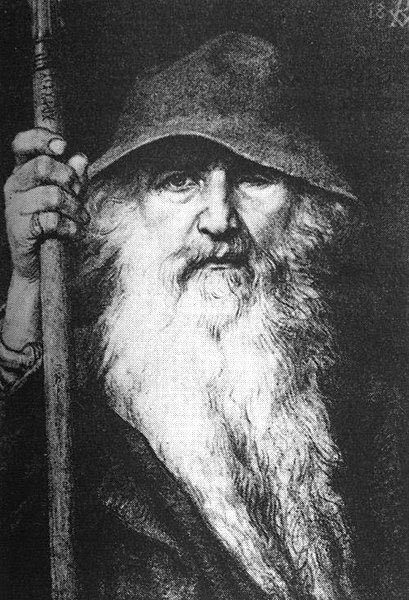 |
| Odin the Wanderer (Wikipedia) |
Note: Read more about the days of the week and where their names come from--including "Wednesday"--in Lesson #01-059. Here we take a closer look at one of them.
Get Ready: Do you know much about the "real" stories of the Norse gods (not just what you can learn from the Marvel movies)?
Every time we say the English name of the middle day of the week, "Wednesday," we pay tacit homage to Odin or Woden (from whose name the word comes), All-Father of the Norse Gods. He is noted for many things, but most importantly for wisdom and knowledge, and associated arts such as poetry, sorcery, and the invention of writing. ("Friday" was named after his wife, the love goddess Frigg.)
There are many stories about Odin. One tells how, with his brothers Vili ("Will") and Vé ("Holiness"), he killed the giant Ymir. Tales of the killing of a primordial being by late-comer gods or heroes are common. The reason for the killing is often rather vague, suggesting a cycle of regeneration rather than any sort of purposeful execution.
And so it was with the death of Ymir. The three brothers fashioned the soil from the muscles of his corpse, the oceans from his blood, the mountains from his bones, and trees and other vegetation from his hair. But they didn't stop there: the clouds came from his brains, and the sky from his skull, which was held up above the earth by four dwarves. His eyebrows made up the Midgard or "middle earth," the area in which we dwell.
Students of Chinese mythology will see in this echoes of the story of Pangu.
The other essential story about the Odin is how he gained his wisdom.
We often see him depicted as an old man with a long beard and a floppy hat. And, as seen in the Thor movies (whose name gives us "Thursday"), he has only one eye. How did this happen?
Odin was driven to seek wisdom at any price. He once hanged himself upside down from a tree for nine days; stabbed himself with his own spear; and undertook long fasts.
But the act that left a lasting mark occurred when he approached a sacred well located among the roots of the central tree of the world, Yggdrasil. The well was guarded by a shadowy figure named Mimir--a name likely related to the English word "memory"--who was all-knowing. When Odin approached the well and asked for a drink--which would grant him wisdom--Mimir insisted that Odin offer an eye and drop it into the well. By taking his drink, the poets suggest, Odin traded one way of seeing for another.
--------Read more: https://en.wikipedia.org/wiki/Odin
Practice: Match the term to its definition below:
- fasts
- homage
- late-comer
- primordial
- regeneration
- shadowy
- sorcery
- tacit
- vague
- vegetation
- plants
- the study of magic
- coming from the beginning of time
- mysterious; unsubstantial
- unclear; not specified
- unspoken; not acknowledged
- honor; reverence
- one who comes after others
- periods of not eating
- re-creation; making over again
Answers are in the first comment below.
Submitted to the Shenzhen Daily for March 29, 2021


Answers to the Practice: 1. i; 2. g; 3. h; 4. c; 5. j; 6. d; 7. b; 8. f; 9. e; 10. a
ReplyDelete